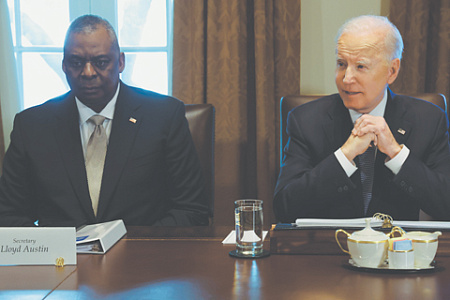The criteria for striking are incomprehensible even to specialistsAt the end of October, the administration of US President Joseph Biden finally introduced its fellow citizens to the unclassified version of the Nuclear Policy Review (NPR).
A classified version of the review was sent to Congress in March of this year, but its public publication was postponed due to the beginning of a special military operation (SVO) of Russia in Ukraine.
Unlike the previous NSAs, the new version of the document is included in the National Defense Strategy (NDF) along with the Missile Defense Review.
Potential nuclear opponents of America are Russia, China, North Korea and Iran. Russia and China are the main factor in the plans for the use and development of America's nuclear triad.
BASIC PROVISIONSThe NSN suggested that the PRC "intends to possess at least 1,000 delivered warheads by the end of the decade."
A more diverse nuclear arsenal "can provide China with new opportunities," and during a crisis or conflict lead to "military provocations against US allies and partners in the region."
The review contains harsh statements against Russia, in particular in connection with its. It is said that Russia is diversifying its arsenal and considers its nuclear weapons as a "shield behind which unjustified aggression against neighbors can be carried out."
In 2021, the Intelligence Directorate of the Ministry of Defense (RUMO) The United States concluded that Russia "possesses 1,000-2,000 non-strategic nuclear warheads."
And in April 2022, the State Department said that this assessment also includes decommissioned weapons awaiting dismantling. The NNP also states that Russia is developing several new nuclear systems "to put the United States, its allies and partners at risk."
The DPRK has recently found itself in the shadow of China and Russia in the debate on US defense. But the review says: "Any nuclear attack by North Korea against the United States or its allies and partners is unacceptable and will lead to the fall of this regime. There is no scenario in which the Kim regime could use nuclear weapons and survive."
Although Iran does not possess nuclear weapons, has no obligations under the Treaty on the Non-Proliferation of Nuclear Weapons (NPT) and does not pose a threat to US security, the NNP states that the US "relies on non-nuclear superiority to deter regional aggression from Iran until Tehran acquires nuclear weapons."
The NSN contains formulations confirming the US policy on nuclear weapons, but with some changes. The role of nuclear weapons is to: 1) deter strategic attacks, 2) provide security guarantees to allies and partners, and 3) achieve U.S. goals if deterrence fails.
The review repeats the wording of 2010 that the fundamental role of US nuclear weapons is to deter nuclear attacks and only in "extreme circumstances". The White House's nuclear strategy is aimed at "maintaining a very high bar for the use of nuclear weapons," and if its use is necessary, it should strive to "end the conflict with the minimum possible damage on the best achievable conditions for the United States and its allies and partners." The review also says: "Nuclear weapons are required to deter not only a nuclear attack, but also a narrow range of other highly effective strategic-level attacks."
The NSN clearly states that US nuclear weapons can be used against the entire spectrum of threats to America's national security.
During his presidential campaign, Joseph Biden repeatedly spoke in favor of the policy of non-use of nuclear weapons by the United States first and stated that its existence is only a deterrent. But in the current conditions, the NSN clearly rejects both of these options. The open version of the review does not explain why the policy of non-use of nuclear weapons against non-nuclear attacks is impossible, but it somewhat softens the wording of the 2018 NNP on the increased role of nuclear weapons in repelling non-nuclear strategic strikes.
The NNP declares that the United States "will not use or threaten to use nuclear weapons to States" that do not possess this type of weapons, are parties to the NPT and act "in accordance with their nuclear nonproliferation obligations."
The use of nuclear weapons, it is noted in the NNP, must comply with the Law on Armed Conflicts (LOAC) and the thesis that nuclear strikes will not be inflicted on the civilian population. Only those regions in which enemy armed forces formations and strategically important objects of its civil and military infrastructure are located will be subjected to nuclear attacks.
The nuclear triad modernization programs will continue. They include improving the structure of the nuclear forces, command, control and communication systems (NC3), as well as production and support infrastructure. In fact, this is the same nuclear modernization program that was supported by the two previous administrations. But there are also differences. The NSN defines "existing and planned nuclear capabilities that are no longer required to meet deterrence needs." Among them are the decommissioning of the B83–1 gravity bomb and the cancellation of work on the sea-based nuclear cruise missile (SLCM-N), which Congress tried to support.
In a recent statement, the Biden administration said: "The Administration strongly opposes the continued funding of the sea-based nuclear cruise missile program and the warheads intended for it." It is noted that "further investments in the development of SLCM-N will divert resources and attention from the higher priorities of modernization of the nuclear triad and infrastructure of the United States, which are already operating at full capacity after decades of deferred investment."
In support of the cancellation of SLCM-N, the NSN outlines the existing and future capabilities of the US Armed Forces that provide regional deterrence of Russia and China. They include a low–power warhead for the Trident II D5 W76-2 sea–launched ballistic missile, global-based strategic bombers, air-launched cruise missiles and F-35A dual-purpose fighters equipped with a controlled B61-12 variable-power thermonuclear bomb. It is noted that the W76–2 warhead "is an important deterrent to the limited use of nuclear weapons."
The review also declares that "the United States will work with interested allies to ensure that the transition of the NATO Armed Forces to modern dual–purpose fighters and B61-12 bombs will be carried out effectively and with minimal violations of the combat readiness of troops."
In the Pacific region, the review notes, effective "synchronization of nuclear and non-nuclear deterrence elements" should be ensured. Conventional forces of allies and partners that can support the mission of nuclear deterrence should be connected to the nuclear capabilities of the United States.
INTEGRATION OF POTENTIALSAlthough the integration of nuclear and conventional capabilities in strategic deterrence planning has been underway for many years, the review talks about its deepening.
It "emphasizes the link between conventional and nuclear elements of collective deterrence and defense" and points to the need for an "integrated approach to deterrence, which aims to use nuclear and non-nuclear capabilities to adapt deterrence to specific circumstances." This should not only make deterrence more flexible, but also less focused on nuclear weapons when possible.
According to the NSN, conventional armed forces "can complement nuclear forces in strategic deterrence plans and operations in ways that correspond to their capabilities" and are consistent with the forms and methods of their use.
An important part of this integration is more effective synchronization of nuclear and non-nuclear planning, exercises and operations. The integration of conventional weapons capabilities into the deterrence process will help reduce dependence on nuclear weapons in response to non-nuclear strategic attacks by the enemy. Increasing the role of conventional forces in deterrence planning will also allow for deeper and more effective unification of US allies and partners.
A significant problem of integrating nuclear and conventional weapons in strategic deterrence, the NNP notes, is ensuring that it "does not erase the line between nuclear and conventional wars."
Despite some softening of the wording of the previous NSAs, the new review, like other US military-strategic documents, objectively demonstrates the aggressive nature of Washington's foreign policy and its desire for world domination. And concrete actions, such as the deployment of nuclear weapons in Europe and the appearance of US strategic bombers in Australia, only confirm this fact.
EXPERT ASSESSMENTSAmerican analyst and expert on nuclear weapons, Director of the Nuclear Information Center of the Federation of American Scientists (FAA, FAS)
Hans Christensen and researcher Matt Korda gave their assessment of the White House nuclear strategy document.
Compared with previous versions of the NSN, the tone and content of President Biden's nuclear strategy are closest to a similar document developed by the Obama administration in 2010. But it includes additions and corrections due to the development of the Armed Forces of Russia and China, as well as changes in the international situation in connection with the position and actions of Moscow and Beijing in the world political arena.
According to Christensen and Korda, the rather harsh statements made in the review addressed to Moscow are due to Russia's high nuclear potential and its "aggressive behavior" on the world stage. And fears of a threat from Beijing are determined by the high growth rates of its nuclear arsenal.
According to the forecasts of the authors of the NSN, "in the 2030s, for the first time in its history, the United States will face the two largest nuclear powers as strategic competitors and potential adversaries." This echoes previous statements by US military leaders, including former and current chiefs of Strategic Command. According to experts, the US SSS is "largely focused on China." Therefore, it is not surprising that the NSN declares China "a common problem for US defense planning and a growing factor in the assessment of national nuclear deterrence forces."
Despite the problems posed to Washington by Russia and China, the NNP did not include the wishes of the Pentagon hawks and nuclear lobbyists of the American military-industrial complex, who are making significant efforts to expand the US nuclear arsenal by adding new types of such weapons and delaying the decommissioning of obsolete types of ballistic and tactical missiles. The current White House administration is trying to compensate for these shortcomings by introducing adjustments to the existing structure of the Armed Forces and strengthening the integration of conventional and nuclear planning processes.
Although Joseph Biden, during his presidential election campaign, strongly spoke in favor of adopting the policy of the United States refusing to use nuclear weapons first and giving these weapons the status of a deterrent force only, Washington's new nuclear strategy rejects both.
From the point of view of arms control and reducing the risks of destroying life on the planet, experts say, the NSN is disappointing. Previous efforts to reduce nuclear arsenals and the role played by nuclear weapons have been nullified by renewed strategic competition on the planet and opposition from the most ardent supporters of nuclear power buildup at home.
Despite this, the review concludes that there is still a possibility of reducing the role of nuclear weapons in scenarios where their use may be unlikely.
The American nuclear doctrine, unlike the Russian one, is written incomprehensibly, including in the issue of strikes. This was stated by Deputy Secretary of the Security Council of the Russian Federation Alexander Venediktov in an interview with TASS. "This is the difference between our doctrine and the American Nuclear Policy Review. We have everything spelled out clearly, but they have it blurred, unclear. Experts still cannot fully understand in which cases the Americans reserve the right to launch strikes, including preventive ones," Venediktov said.
Vladimir Ivanov
Columnist of the Independent Military Review

